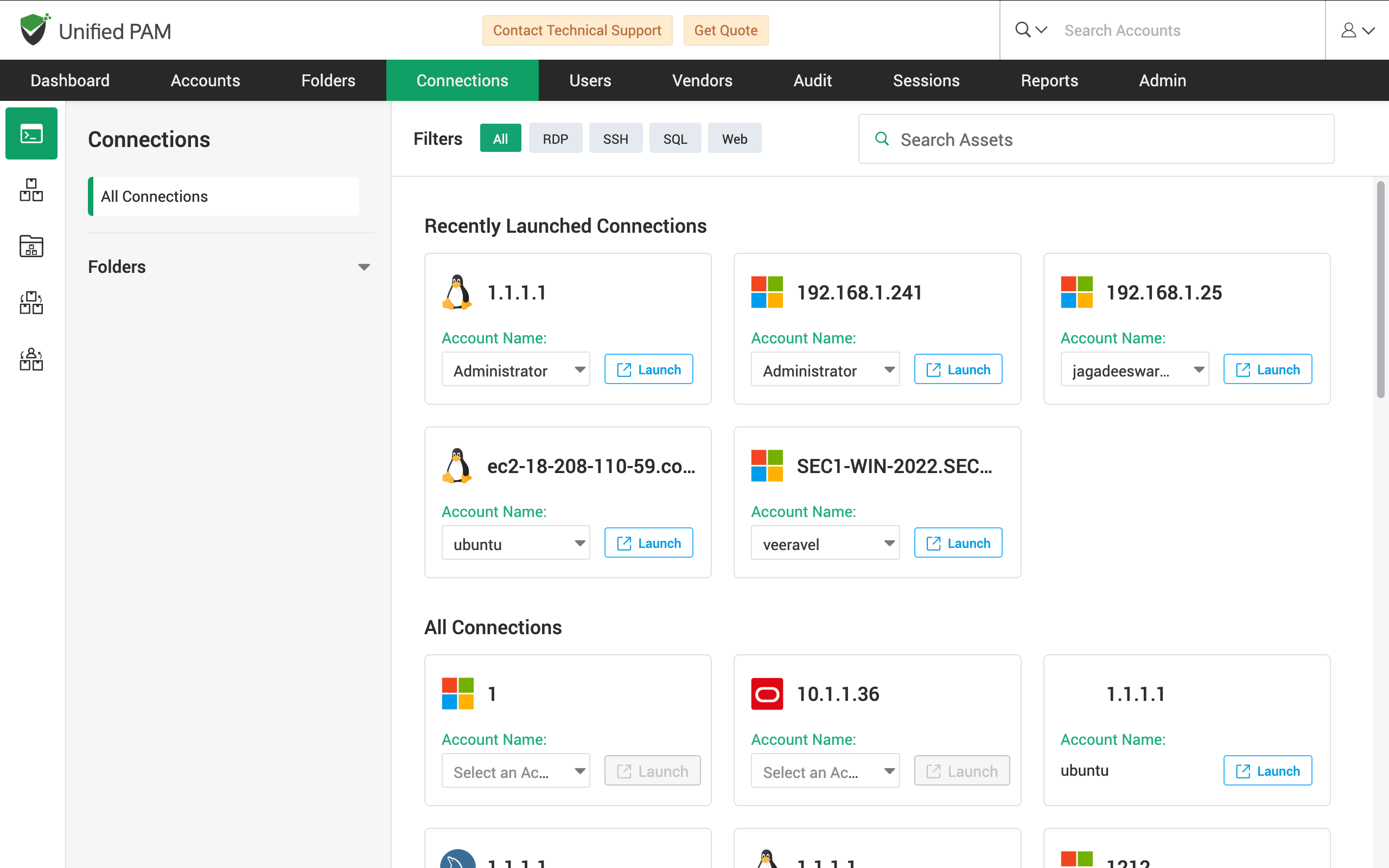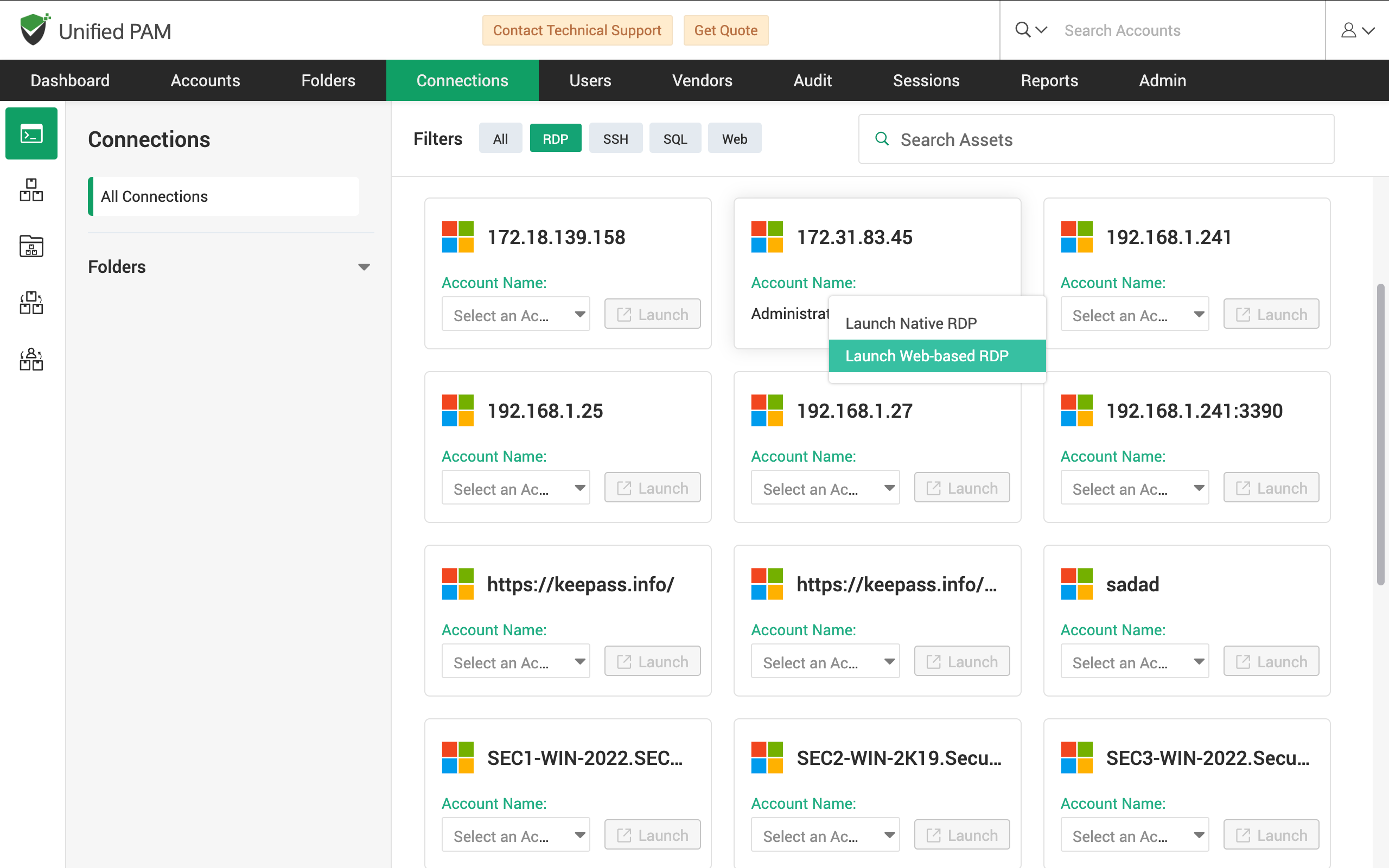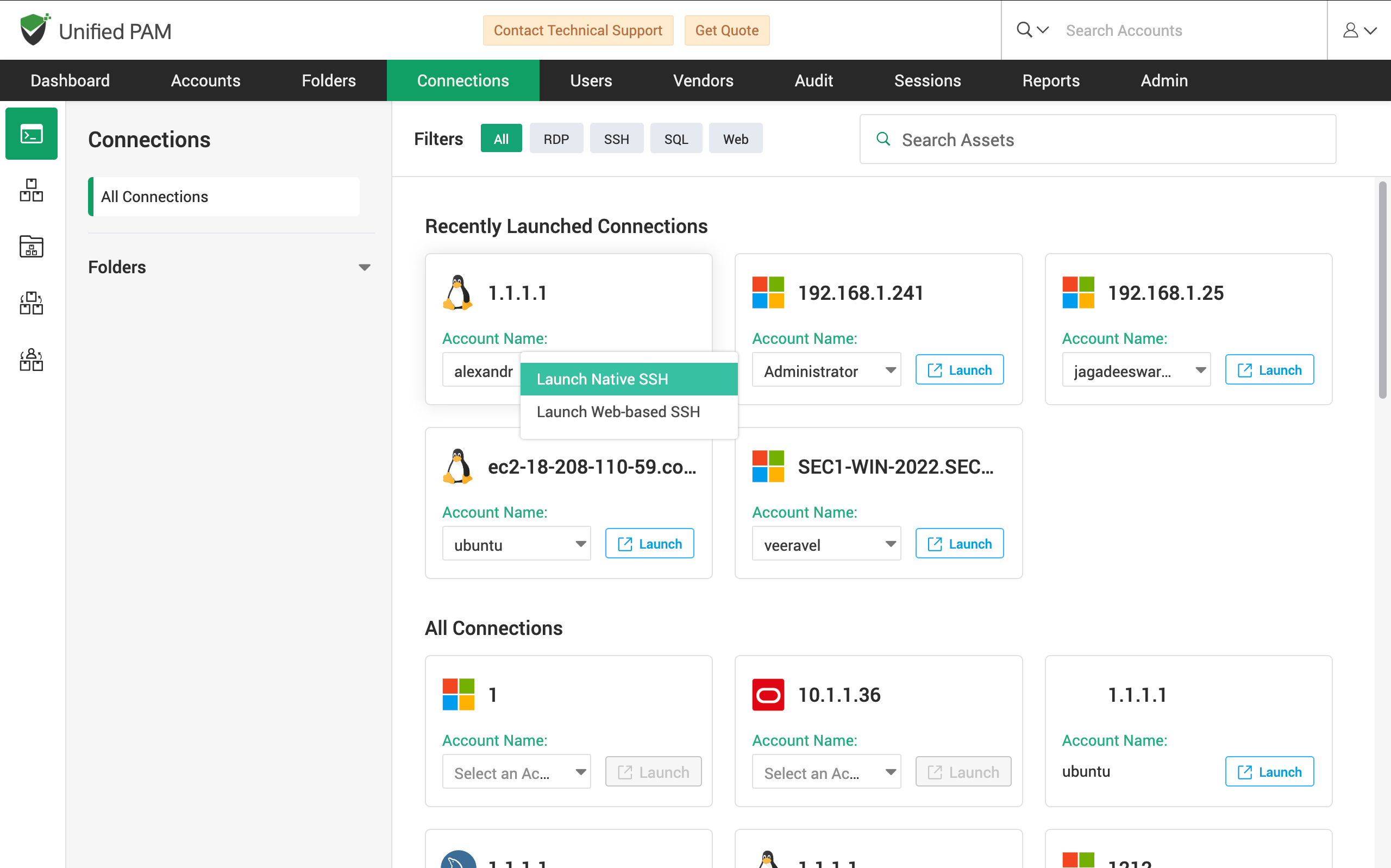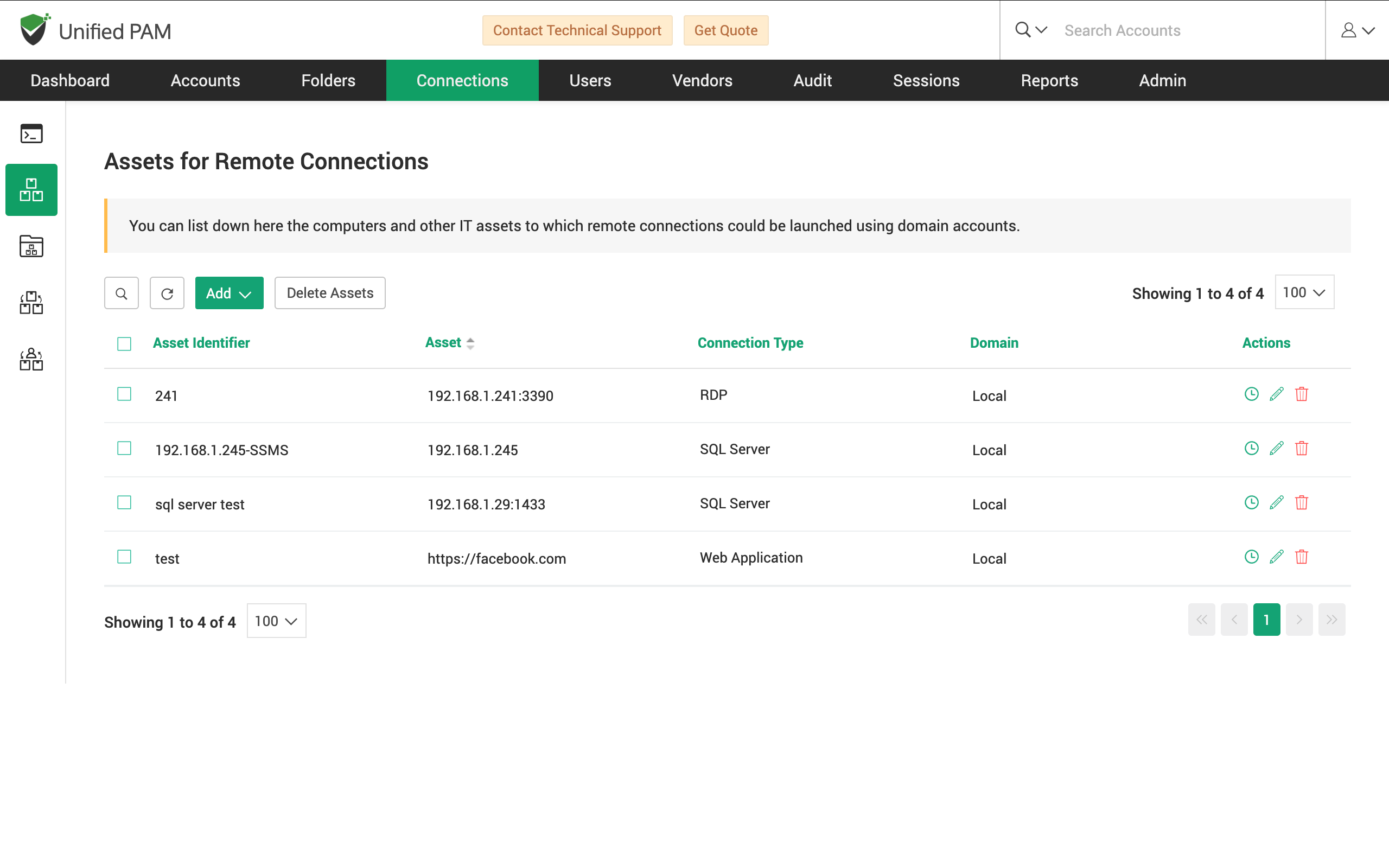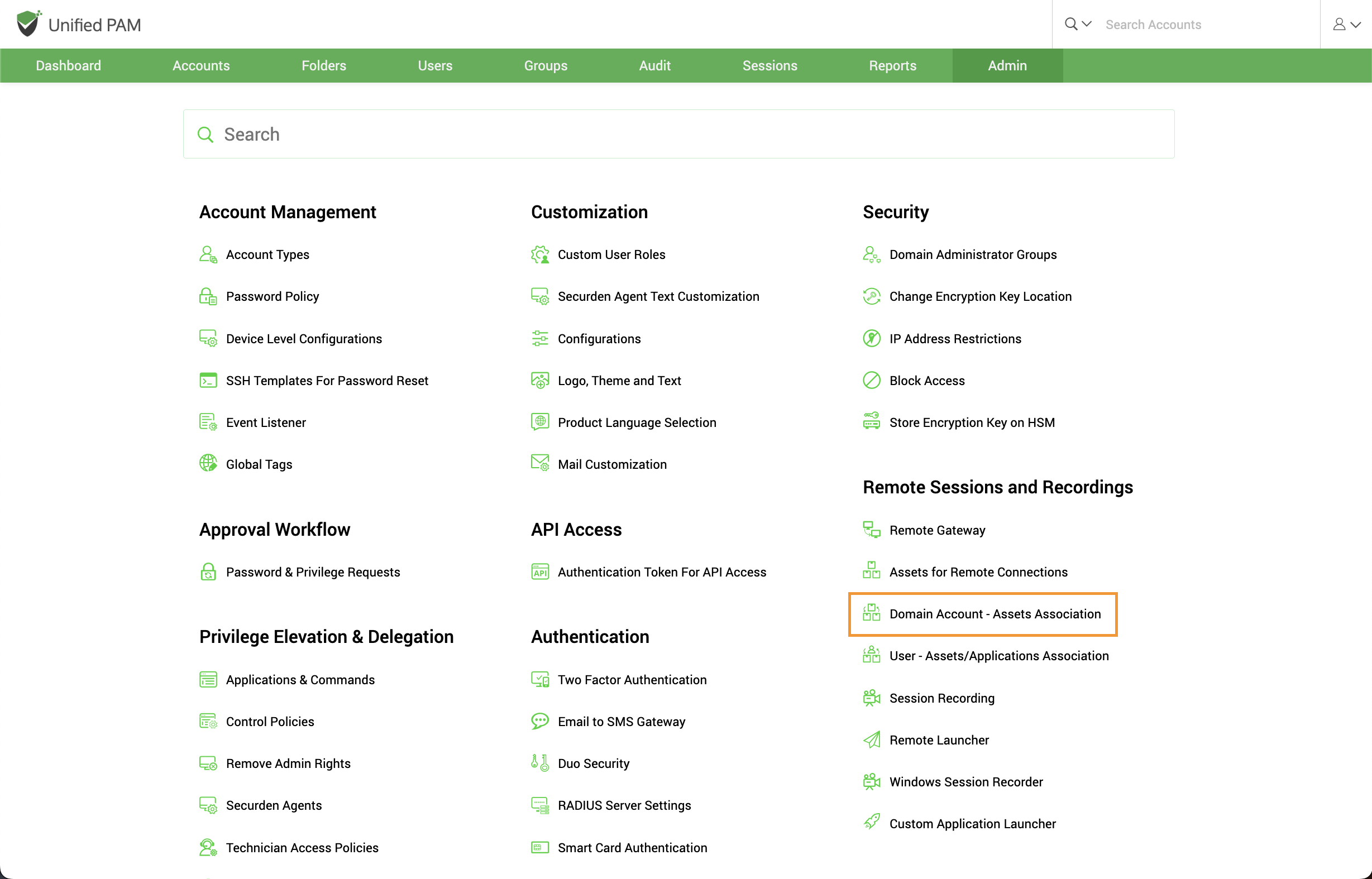Securden Connections Manager¶
Introduction¶
Securden helps facilitate secure, encrypted connections to remote IT resources using SSH, RDP, and SQL protocols right from your desktop. The connections management interface ensures that you can quickly take remote sessions to IT assets for which you have been granted access.
While you can still launch connections from the Accounts tab, the flow requires you to select a specific account and then select an associated asset while launching the connection. For the asset to show up in the account, you would need to create asset-account association from the Admin tab.
The Connections Manager maintains the same intuitive interface as Unified PAM and aims to simplify this process by allowing users to directly choose the device or asset to which they need to connect and then select the credentials available for that asset. They can also create an asset-account association right from the connections manager interface.
Request Release Workflows¶
Access workflows that exist when you launch a connection from an individual account will remain the same when launched from the connections tab. This means that accounts which require approval to be accessed will still need to be approved by the corresponding administrator when the try launching sessions from Connections Manager.
Note
The connections manager is available as part of Unified PAM from version 11.1.0 and Unified PAM MSP version 11.0.0. If you are running a lower version of PAM, you need to upgrade to the latest version to make use of the Connections Management module.
To access Connections Manager, navigate to the Connections Tab in the interface.
Enforce Access Exclusively to Connections Manager (Optional)¶
You can choose to display only the Connections tab to specific users, ensuring that they have no other controls over the privileged access management interface. This will affect all users in Securden who are assigned a ‘User’ role.
If you wish to achieve the same scenario for other users who are not assigned the ‘User’ role, you can make use of the custom user role permission named “Manage connections”.
The configuration to enforce access to connections is available under Admin >> Configurations >> Display Connections Tab Alone.
Filter Connections¶
You have the option to filter connections based on what protocol is used to launch a session. The filters available are:
-
RDP – Primarily used to launch sessions on Windows-based devices
-
SSH – Primarily used to launch sessions on Unix, Linux and Mac devices
-
SQL – Primarily used to launch sessions on Servers & Databases
-
Web Connections – Primarily used to launch website sessions
Launching a Connection¶
To launch a connection, go to the target asset from the list, first select the account that should be used to initiate the connection (This account will carry out authentication on the asset).
Once the account is selected from the drop down, click on Launch to start the remote session. A new browser is opened from which you can access the asset. Users have the option to make concurrent connections to different assets. However, connections can be launched only to one asset at a time.
Monitor and Record Remote Connections¶
All remote connections taken from the connections tab are fully recorded and audited. Administrators can also monitor live connections from the Sessions tab.
Initiate and End Access¶
If approval workflow has been configured for a particular account, users may be granted a time-window, say 30 minutes of access. In this case, upon approval by an administrator, the user must click on [Begin Access] and only then launch a connection. Upon completion of their tasks, they would [Surrender Access].
Cases where connections cannot be launched directly: '¶
-
[Account Locked]: If this message is displayed, it means that the account selected to access the asset has been locked by an administrator in Securden. You may request the administrator to unlock this account or try launching a connection with a different account.
-
[Account In Use]: This message is displayed when the account is in use by another user, you cannot concurrently use the same account to access assets. You may either wait until the other user has ended access or try launching a connection with a different account.
-
[Request Access]: This message is displayed when the approval workflow has been configured for the selected account OR asset. You may raise a request to access the account and upon approval you will be notified. Until then the [Waiting for Approval] status will be displayed.
Note
If approval configured for both the asset and the account, then the account-level workflow will take precedence.
Recent Connections¶
Any sessions launched to remote assets by the user previously are displayed under the Recent Connections tab, this is particularly useful for users to constantly access the same assets.
Assets and Asset Groups¶
You can group together target systems to make your day-to-day privileged access more efficient. Asset Groups will display all systems that are available under it for easy classification and access.
Note
If you have not added any assets or created an asset group, you can do so using the quick access panel on the left.
Add Assets for Remote Connections¶
IT assets are to be added to Securden before you can utilize the connection manager. You may add all such computers and other IT assets by clicking on Add. There are multiple ways to add assets:
-
Add Assets Manually: Specify the type of connection (RDP/SQL/SSH) and the IP address of the asset.
-
Import Assets from AD: Scan your Active Directory domain and obtain the OUs, Groups and computers in the domain. Computer objects are added here as assets for launching remote connections.
-
Import Assets from Azure AD: Scan your Azure AD (Entra ID) and obtain the OUs, Groups and computers present on Azure. Computer objects are added here as assets for launching remote connections.
-
Import Assets from a File: This option helps you add multiple assets at one go. The input for importing assets may be in the form of a standard CSV file or an XLSX file.
While adding the IT asset, you can specify how the device can be connected (RDP/SSH/SQL) and the device’s connectivity details. As mentioned above, the assets added here need to be associated with the required domain accounts - that is, with specific users/user groups and accounts/folders in Securden.
Domain Accounts - Asset Associations¶
Domain accounts are often used to remotely connect to computers and various other IT assets. Any domain account can be configured to remotely connect to multiple IT assets. In such scenarios, creating an association between the domain accounts and the list of IT assets it could connect to, becomes necessary.
Typically, an asset is associated with specific users/user groups and accounts/folders in Securden. That means, you will specify ‘who’ can launch a remote connection to ‘what’ asset using ‘which’ domain account.
Once the association is made, the asset will appear in the list of remote session launch options for the specific domain account for the specific users. You can create any number of such associations from this section.
User – Assets Association¶
You can allow your users to launch remote connections to specific resources using the AD account with which they have logged in to Securden.
In addition, if the user has any accounts that are classified as 'Personal Domain Account' account type, the user can use those accounts too to launch the connection.
In this interface, you can associate the IT assets with the users. This association permits them to launch the connection with the assets allotted.
